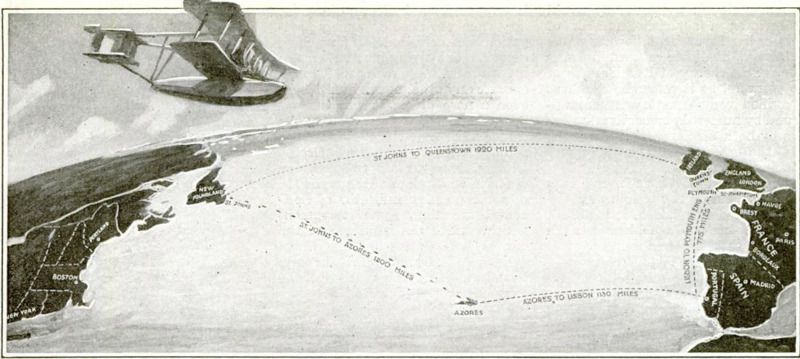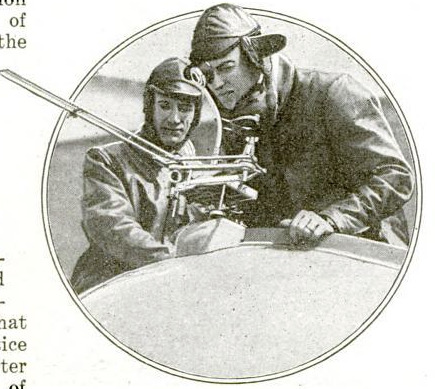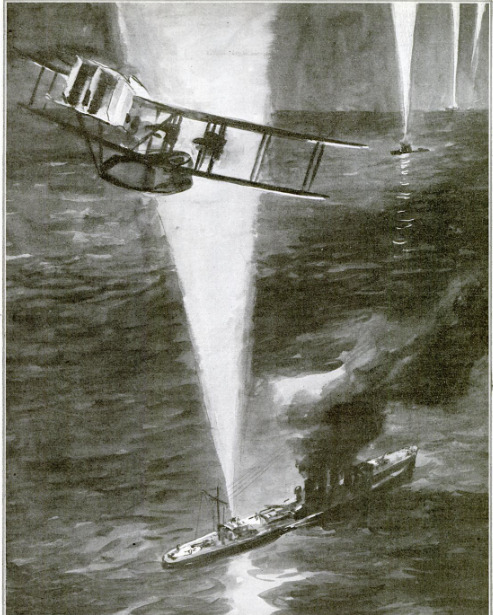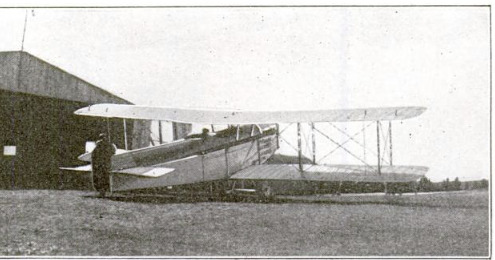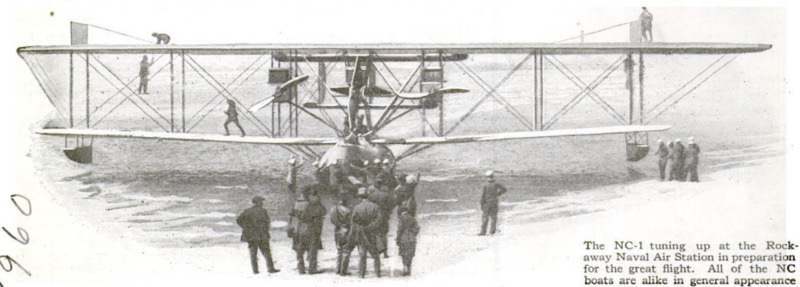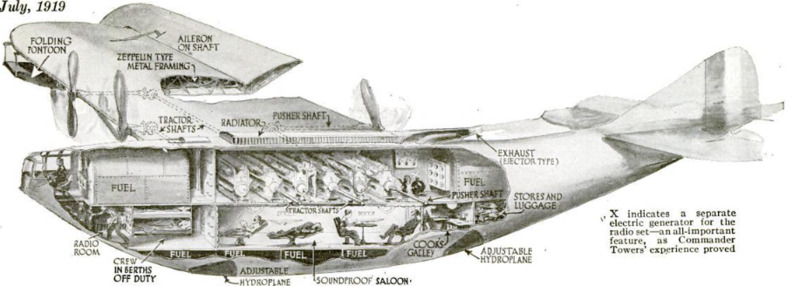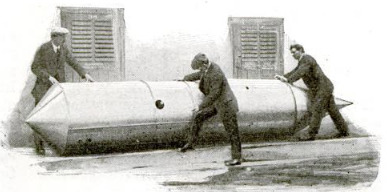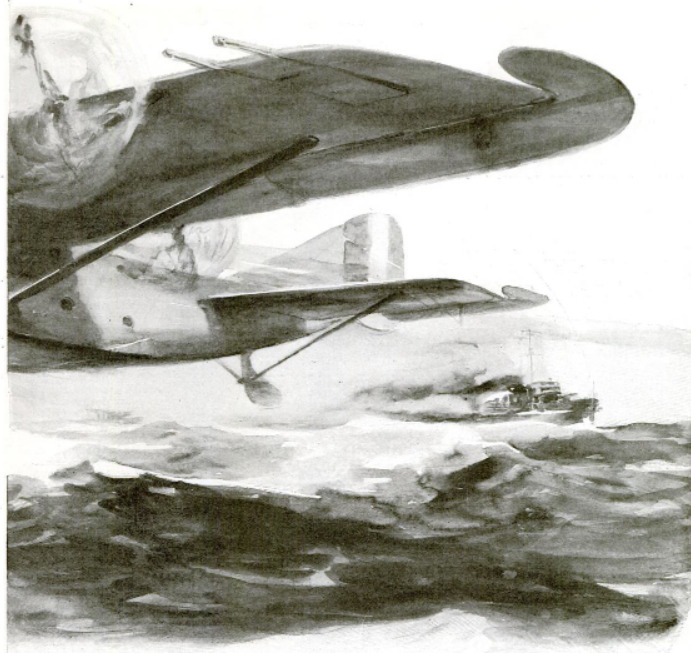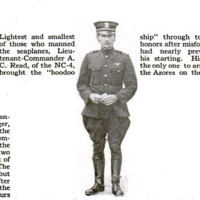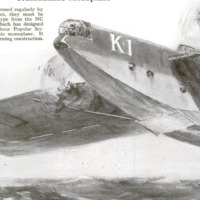-
Titolo
-
Experiment made by the U. S. Navy to test if a transatlantic flight is doable and the Popular Science Monthly's ocean monoplane
-
Article Title and/or Image Caption
-
To Europe in a Flying-Machine. The lessons of transatlantic experiment and the Popular Science Monthly's ocean monoplane
-
extracted text
-
IT is not merely by a poetic fiction
that the daring men who vaulted
into the air from Newfoundland
to cross the Atlantic are likened to
Columbus. To be sure, they taught
us nothing new about the geography of
the world. On the other hand, the
ocean air through which they traveled
is as uncharted as was the ocean of
water in Columbus's time. Meteorolo-
gically, it was a real voyage of dis-
covery.
The American Navy has reason to
be proud of its transatlantic experi-
ment. It was not imbued with the
desire to win a rich sporting prize, but
to prove or disprove a proposition
scientifically. Hence the chain of
destroyers that stretched across the
path of flight.
The essence of a scientific
experiment is control. Every
step must be watched. Nothing
must be left to chance or acci-
dent.
Use Warships as Observatories
For the first time, regular meteo-
rological stations were established
in mid-ocean, among them battle-
ships with a radio range equal to that
of most land stations. The practice
should be continued. What better
use can be made of destroyers, of
battleships that must be kept in com-
mission regardless of expense, than to
employ them as oceanic weather ob-
servatories? Commercial companies,
whose enterprise without scientific |
aid would be as adventurous as that
of Hawker, will derive immense benefit
from such meteorological work of the
Navy; for they will be warned of im-
pending danger. |
One great lesson was learned in the |
great American effort to cross the
Atlantic. It is this: The art of flying
is in advance of oceanic meteorology.
If vessels of the NC type are to
be employed for the crossing of the
Atlantic—vessels lumbering and slow |
in comparison with the swift passenger- |
carrying transatlantic flyer of the fu-
ture—we must be able to predict the
Atlantic weather twenty-four hours in
advance.
The Air—an Uncharted Ocean
Where are the carefully tabulated
observations that make that possible?
Beyond a few joint experiments in
kite-flying made from the decks of the
Prince of Monaco's yacht by Teis-
serenc de Bort and Professor A. Law-
rence Rotch, and by government
scientists from the decks of the
United States Coast and Geodetic
steamer Sencca, nothing whatever has
been done to explore the Atlantic
atmosphere.
Before regular transatlantic flying
becomes a reality, the United States
and Europe must systematically ex-
plore the atmosphere over the ocean,
just as the atmosphere over the land
has been explored from the ground
to a height of about twenty miles.
So competent an authority as the
late Professor A. Lawrence Rotch
predicted, long before our vastly
improved flying-machines appeared,
that it would be feasible to cross
the Atlantic every day of the year
in northern latitudes if the permanent
western planetary winds that prevail
above ten thousand feet could be
used. Unfortunately, support is poor
at such a height; to carry much cargo
there is out of the question. By skil-
fully selecting his level, Rotch argued,
the transatlantic aviator may avoid
head-winds; a sufficient. number of
more or less favorable following winds
are always available at. medium altic
tude. This theory of Roteh's, one of
the pioneers, be it remembered, must
be verifiod by systematic weather stud-
os and by numerous transatlantic voy-
ages by both airplanes and dirigibles.
I the successtul trips of many
machines vindicate Professor Rotch,
commercial transatlantic flying is a
matter of but a few years. In the
presant stage of aviation, it i almost
criminal to use land machines over the
ocean for passenger nervice.
We have maid that meteorology
transatlantic meteorology —has not
kept pace with the demands of avia-
tion. * The obstacles offered by fog
Prove th assertion.
The navigators of the NC flying-
boats know that fog is the aviator's
deadliest peril. Tt may be questioned,
however, whether they were quite
prepared for the poculiar variety of
extensive, obstinate, high-sea fog, com-
bined with a heavy sea, that proved
the undoing of two of the planes on
the way to the Asores.
Tt is the old, old story, but is told
with a new thrill. Tho pilat of the
NCA, suddenly deprived of all his
subconscious visible Indications of
horizontal direction, became confused.
The semi-circular canals of the
middle ear (the spirit lovel in our
heads) tells us whether or not we
are on an even keel. Yet, for some
curious paychological reason, he could
not tell that his vessel was binked-—in
other words, tilted sidewise wo
that it tended to run around in a circle.
Wanted —a Substitute for the
Human Ear
In a fog a flyer's sense of direction
and wonse of Verticality aro so. far
destroyed that he cannot tell at what
angle the machine is banked. To
iuesses at the angle. The compass
is supposed to indicate direction;
but when the needle wanders navi-
gation is demoralized. If a machine
executes one flying maneuver un-
bidden and unperceived, it may
execute any other equally unbidden,
even a nose dive. It was the ap-
pearance of the sun through the
clouds that saved the NC-4 from
running around in narrow circles.
Clearly, it is unsafe to cross the
ocean in an airplane without the aid
of some positive indicator of hori-
zontal direction, some instrument
which, unlike the labyrinth of the
ear, is not affected by centrifugal
force if a mist obscures the sea.
Such an instrument is Sperry’s
gyroscopic level-indicator.
A Great Wireless Station on
the Azores
The flight has also taught us the
vital importance of maintaining
radio communication under all con-
ditions. The commander of the NC-3
had left his ground set ashore. He
paid dearly for that. After he had
alighted he became dumb, wirelessly
speaking. He was able to send mes-
sages only in the air with a trailing
antenna. Although a half dozen
destroyers were near enough to help
him, his seaplane was as hard to see
on the ocean as a speck of dust on a
plate-glass window. Eyes and ears
are appallingly limited in range. Only
radio communication makes it pos-
sible to protect a transatlantic boat
flying in distress.
To lay a true course for the small
islands in the Azores in mid-ocean
is at best a navigation problem of no
mean order. But to lay that course
through the air in a fog requires all
the aid that can be given by modern
radio apparatus.
‘When we consider the mishaps that
befell the NC-1, it is evident that
without radio apparatus of fair range
transatlantic journeys should not be
undertaken. So efficient must the
radio apparatus be that it can be used
for reckoning latitude and longitude
even though the machine may be
compelled to float for hours, and even
days, on the water.
Since the Azores are likely to become
of future aeronautical importance,
they will surely become the site of a
huge radio station, a veritable beacon
of electromagnetic waves to guide
transatlantic flyers as surely as a moth
flies into a flame. At any moment,
when that station is completed, the
transatlantic aero-navigator may de-
termine his location and then head
for the Azores.
It may as well be admitted that,
however romantic it may be to cross
the Atlantic without a stop, the direct
route from Newfoundland to Ireland
is of only academic interest for the
time being. Aerial commerce in
flying-machines will surely move by
way of the Azores, simply because it
must be prepared to fight head-winds.
Over the shorter non-stop route the
machine best adapted to the task
would only waste money. Why is
this? Because the airplane has to
carry fuel in place of money-earning
cargo.
What's Wrong with the
Machines?
The American seaplanes were not
prepared to fight head-winds. They
were slow, heavy, cumbersome. Es-
sentially winged sea-boats, they were
not streamlined with that scientific
care which is so much in evidence in
fast fighting planes. In
this respect the Sop-
with machine of Haw-
ker and the Martinsyde
of Raynham were bet-
ter.
Although the Ameri-
can experiment is scien-
tifically more valuable
than the British, there
can be no doubt that
the transatlantic flyer
of the future will more
closely resemble the
British than the Ameri-
ican machines. Not
that this transatlantic
flyer will necessarily
be a land machine, but
that it will place its
chief reliance on clean-
ness of line, on engine
power, and hence on speed.
The NC planes are merely large
copies of the old Curtiss flying-boat.
The engines are mounted outside of
the hull—an objectionable procedure
because of the air resistance encoun-
tered. Aeronautical engineers are
well aware of this, but they have been
forced to continue the practice because
the propellers must clear the waves.
But the larger the flying-boat, the |
less reason for continuing the practice. |
Any one can see for himself how high
the propellers of the NC boats were |
mounted above the water. |
The NC type has proved itself
decidedly too slow for transatlantic
commercial flying. Its speed of sixty
to seventy-five miles an hour is not
what we expect. It is really a flying
cruiser intended to detect submarines,
and not a transatlantic flyer.
Not one of the machines that
earned transatlantic glory in 1919
was specifically designed for the pur-
pose of flying over the ocean. Haw-
ker’s Sopwith machine is a fast bomb-
dropper. The Vimy - Vickers and
Handley-Page biplanes are likewise
bomb-droppers. Six hundred miles
is the maximum range for which both
the British machines and the American
NC planes were designed. Much
of the elaborate preparation for the
flight can be explained by the provi-
sion that had to be made for carrying
extraordinary loads of fuel for a voyage
far exceeding in length that for which
any machine built today is really
designed.
The Popular Science Monthly's
Transatlantic Monoplane
Although the Americans collected
more practical information on the sub-
ject of transatlantic flying than did the
British, it must be confessed that
transatlantic flying in the future will
duplicate more Hawker's splendid
effort so far as speed is concerned.
If the business man who must be in
London in forty-eight hours is to be
deposited in England safely and surely,
he must be transported in a machine
that will plunge through adverse
winds and storms as readily as the
Mauretania plows through heavy seas.
What will be the aspect of the trans-
atlantic flyer of the future? It must
be an evolution of the fast fighting
airplane if it is to depend on power and
speed. Exactly what form it will take
no man may safely predict. This
much at least is certain: It will have
a completely inclosed body or fuselage;
it will have a speed of
one hundred and fifty
miles, possibly of two
hundred miles, an hour.
The POPULAR Sci-
ENCE _ MONTHLY has
given this problem
some thought. It pre-
sents to its readers the
plan of Mr. Carl
Dienstbach, its aero-
nautical editor. You
will find nothing revo-
lutionary in his plan;
it is based on the experi-
ence of the last ten
years in flying over
land and sea.
Since the machine
must cross the ocean, it
must also carry much
fuel; but the carrying
of a heavy load and the attainment
of high speed are almost incom-
patible. An enormous lifting surface
must be provided to raise the load,
and much of this lifting surface is not
only useless in the air, but decidedly
detrimental because of the air re-
sistance that it offers.
Since there must be the utmost
economy of surface and power, Mr.
Dienstbach has decided that the
machine ought to be a monoplane of
about one hundred feet span. Curi-
ously enough, the late Count von
Zeppelin, after devoting the last
months of his life to the construction
of a mammoth seaplane, also arrived
at the conclusion that a monoplane is
the correct type—a conclusion of
which Mr. Dienstbach was not aware
at the time he designed the POPULAR
Science MoNTHLY flyer.
Mr. Dienstbach was inspired by the
monoplane of Mr. Grover Cleveland
Loening, probably the fastest that has
thus far been designed and built. The
Loening construction lends itself well
for the purpose because it is so
stanch, because it does away with
fuel-wasting projections, and because
it consumes little power for the speed
attained.
Now, in any transatlantic flyer,
speed is dependent primarily on per-
fect streamlining, which means that
every projecting surface must be so
designed that the air is parted with the
least possible resistance. It wes the
French designer Nieuport who was
the first to attain racing speed in this
scientific way.
The narrow high fuselage of the
Loening construction is a great ad-
vantage because the engines can be
placed within the streamlined hull.
Because the machine has but a single
surface it encounters less resistance in
its onward progress than a biplane.
At the start of a flight with full load
it is practically impossible to vary
speed; but toward the end of the
voyage the speed becomes more ad-
justable as fuel is consumed. More-
over, the flying angle can be reduced
from that of the utmost efficiency
for lifting to a flatter angle, which
means still higher speed.
The mechanical advantage
of having the engine inside the
hull is obvious enough. But
will not the passengers be in-
convenienced by the noise, odor,
and vibration? Not if they are
literally sealed in a mechanically
ventilated saloon provided with
padded walls. Of course, the
quarters will be cramped, but
not more so than in the NC
flying-boats. They cannot walk
upright; but they can lie com-
fortably on couches. Moreover,
the passengers will be provided with
every luxury. Their quarters will not
only be ventilated, but supplied with
warmed air. If the spectacle of an
ocean dotted with ships interests them,
they can enjoy it by looking out of their
port-holes. There will even be elec-
trieally cooked hot food prepared by
a small cook, probably a Japanese, who
must be a veritable genius. He will
act as steward, purser, deckhand, and
‘maid-of-all-work.
It Will Have to Be a
Flying-Boat
The POPULAR SCIENCE MONTHLY
fiyer must be a flying-boat, for it is
impossible to make a preliminary run
at high speed on wheels in so large and
heavy a machine. The machine that
Mr. Dienstbach has in mind can vault
into the air only if it can carry its
Toad at maximum speed.
Suppose the machine were mounted
on ice-boat runners, and suppose that
the ice area were infinite. In other
words, a flying-machine thus mounted
on runners would gather speed, travel
faster and faster, until finally it would
rise into the air. So long as the
preliminary run is fast enough, the
heavy load can be lifted. A way must
be found to run or glide over liquid
water as fast as it is possible to slip
over ice. Much has been done in
this direction by the hydroplane, hut
nothing comparable with ice-boating.
This solution is offered: Increase
the hydroplane speed by reducing
the long, wetted, adhesive hydroplane
surface, and give that surface such a
shape that the maximum lift is at-
tained with the least drag. This
becomes possible if the machine
is able to rise clear of the water on
one step In front—a step of correct
design.
Now, this small hydroplane area
will lift the whole load only at very
high speed, and very high speed can-
not be attained until the whole weight
is lifted. We seem to be running
around in circles. The only solution
is to make this same small surfaco
lift exceedingly even at slow speed,
while the hull of the flying-boat is
still in the water and offering therefore
much resistance to onward progress.
This end could be attained by what
the airplane designer calls a variable
camber surface.
By camber is meant the curvature.
It is hard to change this camber in the
wing of an airplane; in fact, it has
not been successfully done, because
the complex construction necessary
‘makes the wing either too heavy or too
flimsy. But in a hydroplane varia-
tion of camber becomes feasible. Re-
member that in the water steel can
be used, something solid and thick;
the construction can be simplified.
A hydroplane with a variable surface
would act like a kind of erow-bar,
a long lover to lift the craft.
Hydroplane surfaces can be placed
directly below the load and
can be controlled from their
centers.
You have only to picture to
yourself a well in the hull above
this adjustable step or hydro-
plane, much the same kind of
a well that receives the center-
board of a cat-boat. In this well
is a row of hydraulic cylinders.
The pistons emerging from the
cylinders are fastened to a flex-
ible steel plate lying normally
flush against the bottom of the
hull—a plate reinforced at the
fastening points by strong lateral
steel ribs.
Pump the cylinders full of water or
empty them to a variable degree, and
the steel plate can be made to bulge
out or to flatten; any degree of con-
cavity can be obtained. The location
on the hull is such that if it be given
no curvature—only a slight downward
slant from front to rear—it constitutes
the step so familiar to motor-boat
speeders. With the help of subsidiary
vertical surfaces adjoining it and
moving in harmony with it (vertical
surfaces that are slight prolongations
of the hull's sides), it performs the
familiar function of a step—a step
that may be folded in the air against
the hull so that it will offer no re-
sistance. If the step be given a steep
slant and a suitable curve, that ac-
celerates the impinging water so sweet-
ly downward that no eddies occur
(exactly as a high lift wing acts in the
air), and a trifle of a reverse ‘‘S” curve
at its tail end to dismiss the stream
smoothly, it needs must give a strong
upward pressure at lower speed as
well, while the hull is still in the water.
The hollow Space behind the lowered
plate and the vertical side plates
communicates, of course, with the
air through the well above.
Getting Off the Water
Let us watch the step in action.
We start with a marked curve to the
hydroplane to lift the hull out of the
water at low speed. When the hull
is well out we reduce the curve and
increase the speed. Finally all the
weight is carried at extreme speed on
the small front step. A similar step
behind the center of gravity serves
as an elevator in the water.
There is also a small vertical rudder
which projects into the water and
which is low enough to remain there
after the tail has been raised by the
elevator. Of course, the aerial con-
trols help these water controls far more
than in the ordinary flying-boat be-
cause the water speed is so much
higher. Once the propellers are run-
ning, side balance is maintained en-
tirely by the usual wing ailerons. These
ailerons are very long, nearly as long
as the wings, and across them blows
the strong slip-stream of the propellers.
Since air resistance is so important,
we must look for the utmost cleanness
of line in flight. We have not an ounce
of fuel to waste. The hull of the
flying-boat must be given a better
streamline than is to be found in the
hulls of the famous NC planes. And,
above all, it must be possible to fold
away the side floats or pontoons that
support the outer wings. Of course,
this is no original idea. It has been
found difficult to fold away the wheels
of land machines, because they must
be strong to stand severe shocks, and
yet light. But floats, which are al-
ways necessary when a single center
hull is employed, need not be called
upon to withstand heavy shocks.
Therefore, as our drawing shows, they
can be swung back into recesses in the
wings and covered with sliding screens
when the machine is in motion. With
the slip-stream side control just de-
scribed, they are required only when
the craft is at rest on the water.
The very size of the monoplanesolves
the propeller problem. The propellers
can be mounted out on the wings, so
that they can be driven through bevel
gears by the athwart-ship engines.
Nothing is detracted from efficiency,
because the single reduction gear can
be embodied in the bevel gear.
So solid and thick is a monoplane
wing of the Loening type that there
is ample strength and space for the
propeller shaft mountings. In order
to attain the speed desired—two hun-
dred miles an hour—six Liberty en-
gines and six propellers (four in front
and two in the rear of the wings) are
specified to attain the best compromise
between efficiency and structural
strength. The length of tubular shaft-
ing required is only a slight dis-
advantage; on dirigibles such shafting
was employed long ago.
It Can Live in Rough Seas
The radiators have been borrowed
from the Curtiss models, and likewise
the long ailerons. Mr. Curtiss has
given us a radiator of minimum re-
sistance that has great cooling effi-
ciency. Mr. Dienstbach has moved it
from the sides of the fuselage to the
top and shaped it like a long trunk.
It will then act somewhat like a fin;
but the chief advantage is that it is
possible to utilize the exhaust as it is
utilized on a locomotive—to send an
extra strong draft through the radia-
tor, cooling it in spite of the sti
further reduced head-resistance.
A craft of the compact type that
the POPULAR SCIENCE MONTHLY has
in mind can live in a really rough sea
when unable to rise from it. Must it
wallow helplessly? Not at all. It
proceeds on its own power, runs
through a storm faster than it con-
nects with a destroyer. The flyer
will always start and alight in mod-
erately sheltered water.
When we fly to Europe we shall not
need a string of destroyers across the
ocean to help us in an emergency, nor
need we wait patiently day after day
until the weather conditions are favor-
able. If transatlantic flying is to be
commercial the crossing must be made
according to atime schedule. Thetime-
tables may be as elastic as that of a
steamship so far as arrival is concerned.
If that ideal is to be realized, speed is
necessary—extreme speed which makes
it possible to cope with contrary winds
without lengthening the trip immeas-
urably beyond fuel endurance.
-
Autore secondario
-
Waldemar Kaempffert (writer)
-
Carl Dienstbach (Article writer)
-
Lingua
-
eng
-
Data di rilascio
-
1919-07
-
pagine
-
71-77
-
Diritti
-
Public domain (Google digitized)
-
Archived by
-
Davide Donà
-
Alberto Bordignon (Supervisor)
